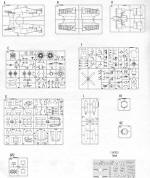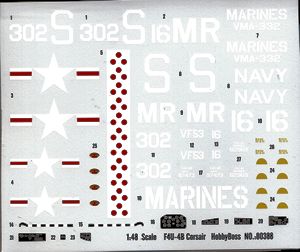
Hobby Boss 1/48 F4U-4B Corsair
| KIT #: | 80388 |
| PRICE: | $55.99 SRP |
| DECALS: | Two options |
| REVIEWER: | Scott Van Aken |
| NOTES: |

| HISTORY |
| THE KIT |
 This
is the latest version of HobbyBoss' -4 Corsair to be produced and it is
pretty much the same plastic as what came in the late version released about
8 months back. In fact, it is the same plastic with all of the sprues in
this kit being the same as what was in the previous release. The only
difference is that this one does not have the two weapons sprues that came
in the -4 (late). Instead, one uses the cannon barrels located on the F
sprue for this and you have to open up some additional holes on the underside of the kit. One thing that was changed is that the clipped wing tips in the previous boxing has been corrected, so that is nice to see.
This
is the latest version of HobbyBoss' -4 Corsair to be produced and it is
pretty much the same plastic as what came in the late version released about
8 months back. In fact, it is the same plastic with all of the sprues in
this kit being the same as what was in the previous release. The only
difference is that this one does not have the two weapons sprues that came
in the -4 (late). Instead, one uses the cannon barrels located on the F
sprue for this and you have to open up some additional holes on the underside of the kit. One thing that was changed is that the clipped wing tips in the previous boxing has been corrected, so that is nice to see. Instructions
are well drawn and offer a variety of paint company references. The full
color markings guide provides for two overall gloss sea blue planes. One is
the box art aircraft from VMA-332 aboard the USS Bairoko in 1953. The other
is with VF-53 from the USS Essex in 1952. This is a rather colorless
offering with no squadron colors anywhere on the aircraft. Decals are well
printed and include instrument panel and side console decals as well as
decals for the tail hook. These latter ones are in a right and left mode
rather than the usual wrap around most other companies use. Personally, I
would paint these as I cannot see how the decals would work successfully. I
have darkened the decal sheet considerably to allow the white bits to be
seen.
Instructions
are well drawn and offer a variety of paint company references. The full
color markings guide provides for two overall gloss sea blue planes. One is
the box art aircraft from VMA-332 aboard the USS Bairoko in 1953. The other
is with VF-53 from the USS Essex in 1952. This is a rather colorless
offering with no squadron colors anywhere on the aircraft. Decals are well
printed and include instrument panel and side console decals as well as
decals for the tail hook. These latter ones are in a right and left mode
rather than the usual wrap around most other companies use. Personally, I
would paint these as I cannot see how the decals would work successfully. I
have darkened the decal sheet considerably to allow the white bits to be
seen.
| CONCLUSIONS |
It is nice to see the cannon armed version done as it is a major improvement over the Academy kit and will allow the Corsair fan to have a more modern version for the shelves.
| REFERENCES |
My thanks to Squadron Products for the preview kit. You can get yours today at your favorite retailer.
July 2013
If you would like your product reviewed fairly and fairly quickly, please contact me or see other details in the Note to Contributors.